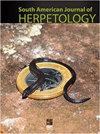Do Crocodilians Eat Plant Material? A Review of Plant Nutrients Consumed by Captive Crocodilians
IF 0.7
4区 生物学
Q4 ZOOLOGY
引用次数: 5
Abstract
Abstract. Several species of crocodilians consume, digest, and benefit from plant nutrients, and the animal food industry has made important efforts to use different plant materials in the development of new pellets for these animals. This information is very important within the ambit of captive breeding and crocodilian nutrition. The search for plants to supplement the diets of crocodilians is important because it may help to satisfy the nutritional demand of captive crocodilians and reduce the costs of their feeding and production. These initiatives have been mainly focused on animals such as fish and poultry, although some research has also been carried out with crocodilians. The demand for crocodilian skin and meat spiked during the 1990s. Since then, efforts have been amplified to investigate the use of different plants in the development of artificial diets to replace or complement the diet of different crocodile species, without interfering with product quality, health, and animal development while keeping production cost low. To achieve this, the existing information about the main and new sources of plant raw materials used to feed crocodilians must be known.鳄鱼吃植物吗?圈养鳄鱼消耗的植物营养素研究进展
摘要几种鳄鱼消耗、消化并受益于植物营养,动物食品行业在为这些动物开发新的颗粒时,已经做出了重要努力,使用不同的植物材料。这些信息在圈养繁殖和鳄鱼营养方面非常重要。寻找植物来补充鳄鱼的饮食很重要,因为这可能有助于满足圈养鳄鱼的营养需求,并降低它们的饲养和生产成本。这些举措主要集中在鱼类和家禽等动物身上,尽管也对鳄鱼进行了一些研究。20世纪90年代,对鳄鱼皮和鳄鱼肉的需求激增。从那时起,人们加大了力度,研究在开发人工饮食中使用不同植物来取代或补充不同鳄鱼物种的饮食,而不会干扰产品质量、健康和动物发育,同时保持低生产成本。为了实现这一点,必须了解用于喂养鳄鱼的植物原材料的主要和新来源的现有信息。
本文章由计算机程序翻译,如有差异,请以英文原文为准。
求助全文
约1分钟内获得全文
求助全文
来源期刊
CiteScore
1.50
自引率
0.00%
发文量
10
期刊介绍:
The South American Journal of Herpetology (SAJH) is an international journal published by the Brazilian Society of Herpetology that aims to provide an effective medium of communication for the international herpetological community. SAJH publishes peer-reviewed original contributions on all subjects related to the biology of amphibians and reptiles, including descriptive, comparative, inferential, and experimental studies and taxa from anywhere in the world, as well as theoretical studies that explore principles and methods.

 求助内容:
求助内容: 应助结果提醒方式:
应助结果提醒方式:


